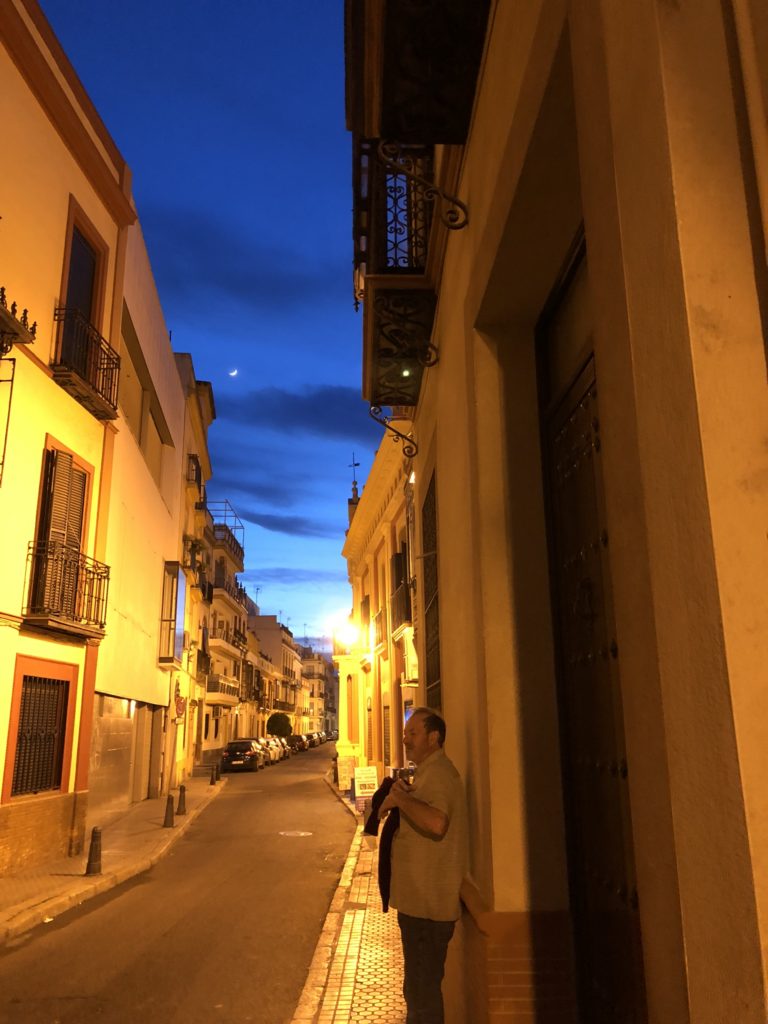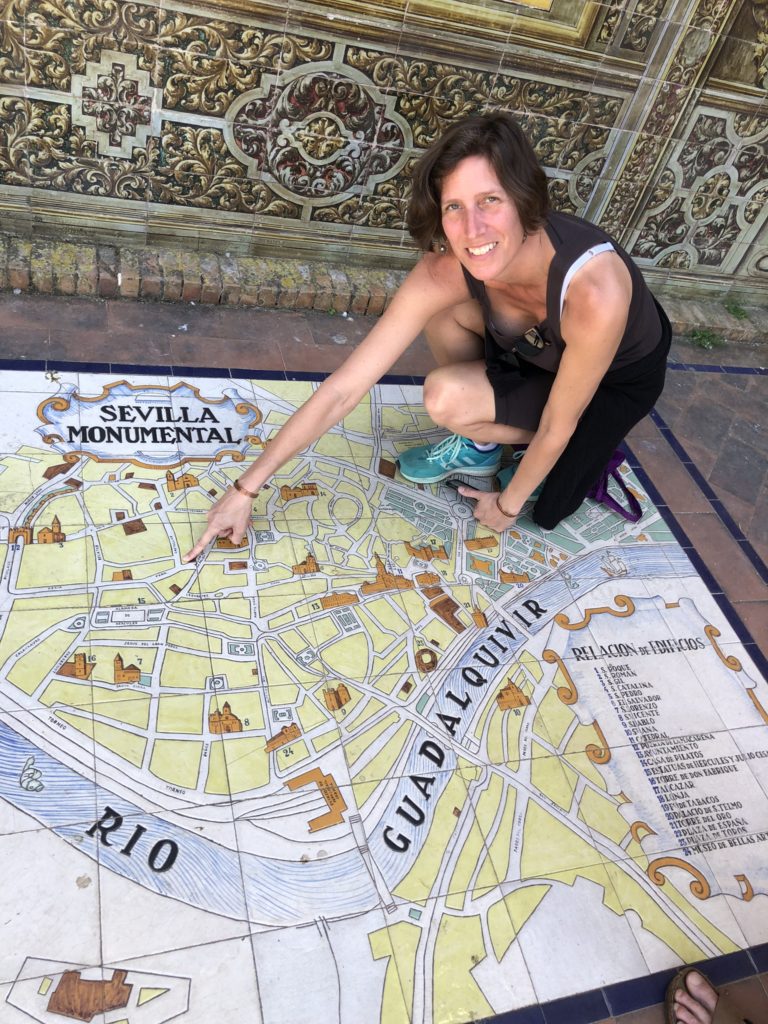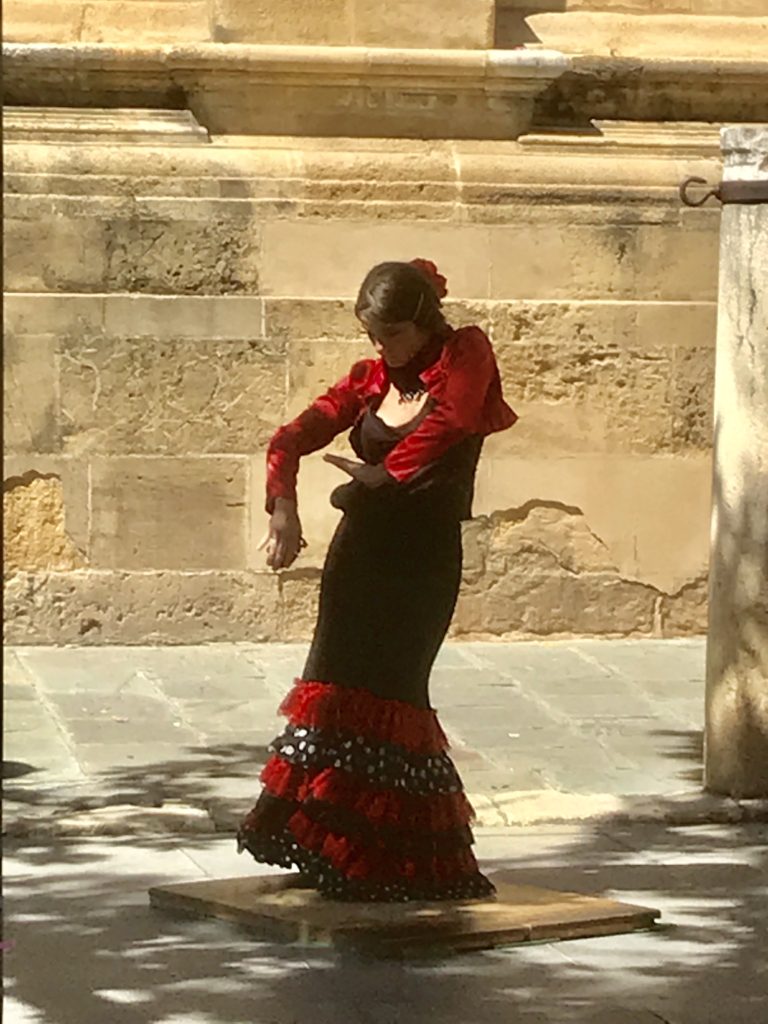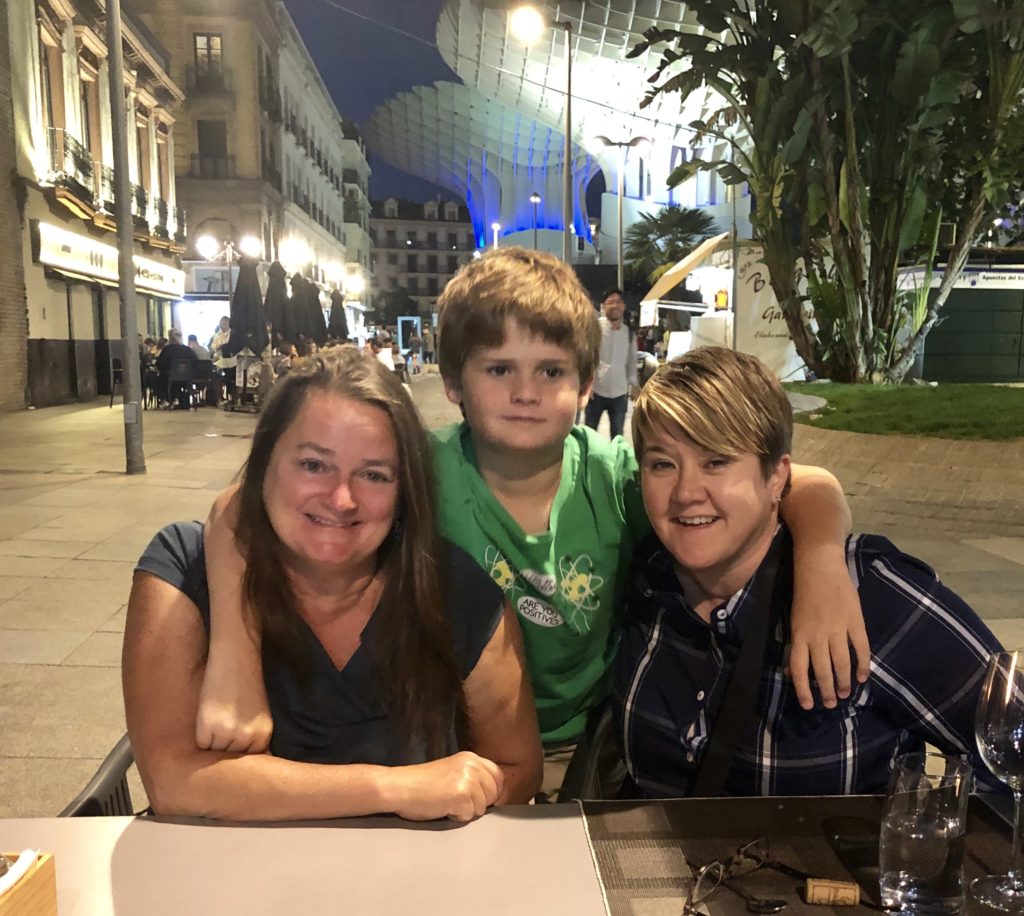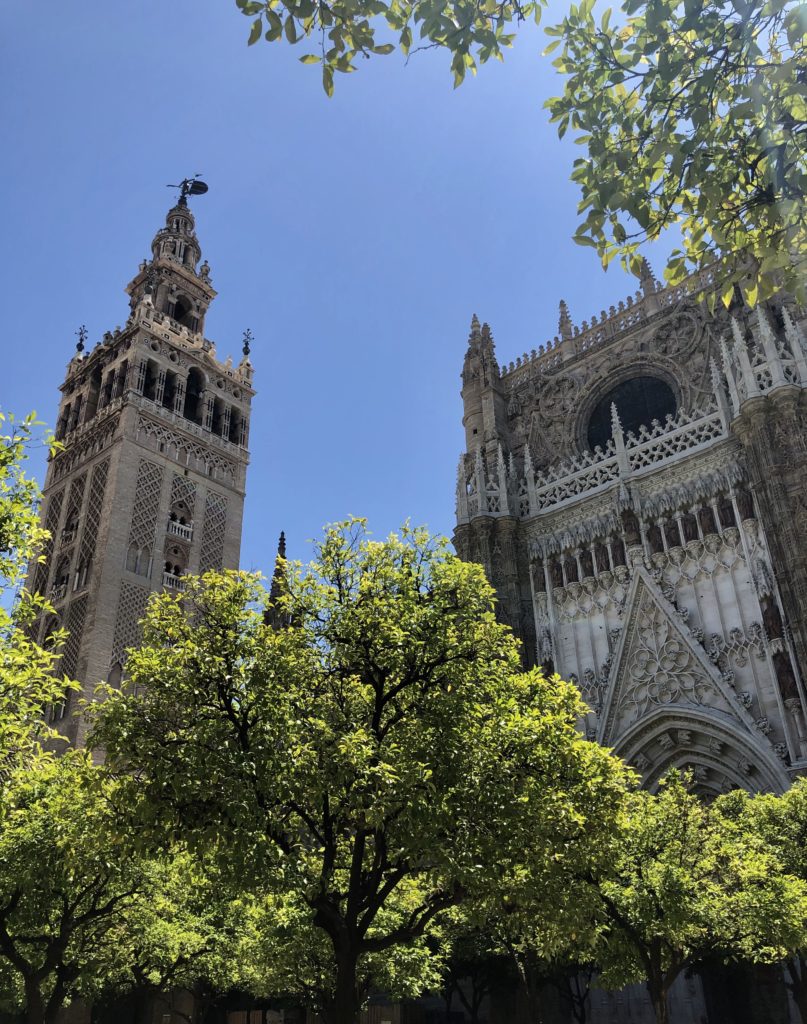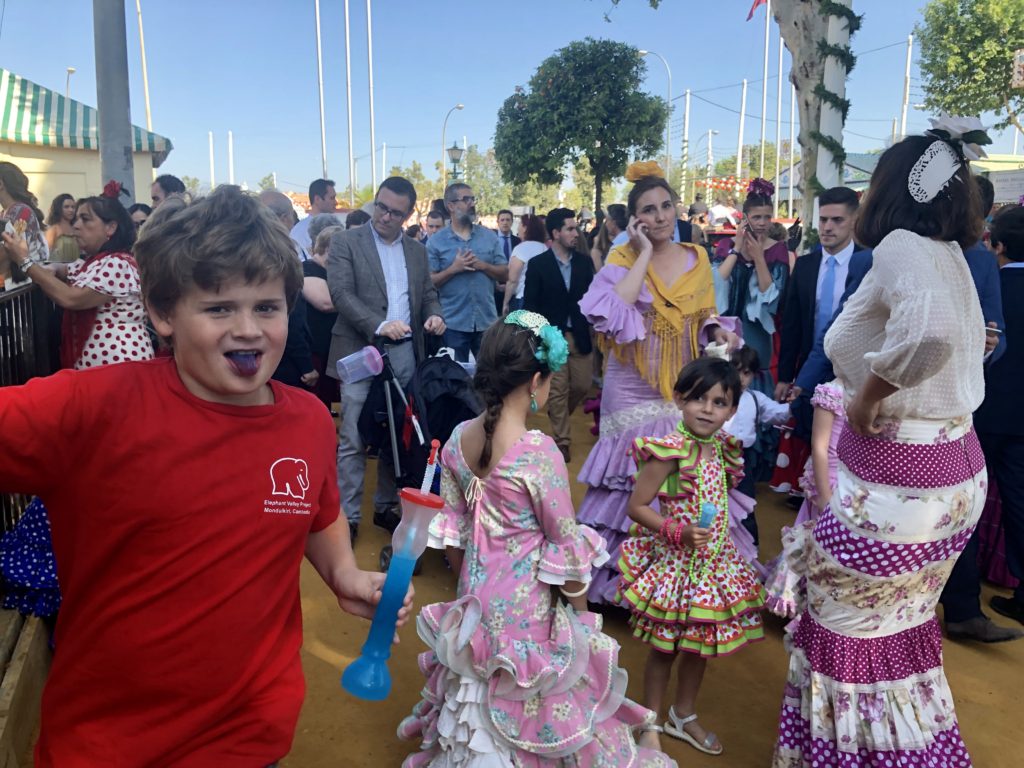We’ve had almost four weeks in Sevilla now, and I will try to put together some of my thoughts about this lovely place.
It might be my favorite city, ever. What else could compete? Chicago, of course, but I can’t count Chicago. Buenos Aires was amazing but Sevilla seems more intimate, more ancient. New Orleans? San Franciso? San Sebastian? I think I would still pick Seville.
When Molly and Steve arrived, I had already been here for two weeks. She asked me lots of questions about Sevilla and Spain, and I had to Google most of the answers. Because although I am very comfortable speaking Spanish, I knew very little about the culture of Spain. Julie and I came here for three weeks in 2007. We visited the Guggenheim in Bilbao, Lili and Felipe in Barcelona, the Rioja Alavesa and Parque Nacional Ordesa, and San Sebastian, but really I do not know Spain, or Spaniards. I know Mexicans.
“Never leave Spain, ” Paul Gleixner advised us via text, while Laura was visiting. He was stuck in Chicago’s April snowstorm. Spain is so amazing; I would love to come back for another block of time. But it would be good for me to have some kind of a role in Spanish culture if I came back, a job or a volunteer gig or something. Or maybe I could just pretend I was writing a book, and hang out at some local joints all day, doing “research”?
We arrived in Seville on the Thursday of Holy Weeks, Semana Santa. I had decided on my round-the-world itinerary without first consulting the liturgical calendar, but it seems that my lack of insight was fortuitous. We would be in Seville for both Semana Santa and Feria. Charo, my AirBnB landlady, showed us around the apartment and talked to us about the upcoming Semana Santa events. I booked the place so long ago that she had not had time to raise her rates, as she usually does in high season, but she was very gracious and gave me a pass.
I wondered how I was going to talk Declan into lining up for a religious parade, but I needn’t have worried. Early on the morning of Good Friday, I woke up to a marching band, and a parade of Nazarenos right outside my apartment window. This was the parade of the “madrugada”, the doleful procession commemorating the death of Jesus. I had such a great view! The Nazarenos are “brotherhoods”, or “cofradias” who participate in the Semana Santa processions, wearing cone-shaped hoods with robes and capes, looking like all the world like the Ku Klux Klan. Frankie commented on my Facebook post, “That looks scary!” But this is Seville, not Alabama, so no need for fear. The Nazarenos are hooded because all penitents should be able to confess in anonymity. They wore black hoods for the mournful Good Friday processions, white hoods for the celebratory Easter processions. I saw a disabled person in a Nazareno outfit on a power scooter, kids dressed like Nazarenos, and cute little Nazareno goodies for sale at the bakery. The crowds were friendly, on the ground and on the balcony. My balcony neighbor had a party to watch the procession, with beer and barbecue in the early morning of Good Friday. Incense and tubas, candles to light the early morning.
Francesco, an Italian doctor I had worked with in Santa Clotilde, saw my Facebook post about Seville, and all of a sudden we have dinner plans! He and his girlfriend will be in Seville tomorrow!
Later on, when Laura was here, we visited the Basilica of the Macarena in the north part of the city, about a ten-minute walk from my apartment. We had gone to see the 2000-year-old Roman walls still guarding the northern portal of the city, and we stopped in to see the Macarena. I had only known “Macarena” as the Los del Rio song by the same name, but it turns out that here in Seville, the Macarena is Nuestra Senora de la Esperanza, Our Lady of Hope; she is Mary with tears running down her face, and she is behind the altar at the Basilica, not Jesus. Mass was in progress when Laura and I arrived, so we headed to the little Macarena museum to kill some time.
“I think that’s the float that went by my apartment!” I told Laura. I pulled out the photos on my iPhone to compare to the float in the museum. “It is the same one!” Sure enough, same float. We asked the museum’s maintenance guy how they got the floats out from the second floor of the museum. “Trap door”, he said, pointing to the floor under the float. “And see, although Mary’s robes are on the float, Mary is not there. She is in the church.” It turns out that during Semana Santa, they take the Macarena out of the Basilica and parade her around town.
The museum has many different elaborate outfits for Mary: velvety capes with glittering embroidery. Colors for the different seasons of the liturgical calendar. Even a black outfit, apparently. When we went to the bullfighting museum at the Plaza de Toros de la Real Maestranza de Caballeria de Sevilla , we learned that two of the greatest bullfighters of all time hailed from Seville. One was Juan Belmonte; the other was “Joselito”, Jose Gomez Ortega. He was gored to death by a bull at the age of 25, and the Macarena was dressed in black to acknowledge the heavy grief of the public, a tribute that has never since been repeated.
It is interesting because I do not think of the Spanish as very religious. Google tells me that 68% of people identify as Catholic, 27% as nonbeliever or atheist, 5% other or no response. Most people who identify as Catholic rarely go to mass, but the streets were packed for the Semana Santa processions. The sushi place across the street is called La Hermandad del Sushi, the brotherhood of sushi, a nod to the various brotherhoods of Nazarenos that have specific social missions, like Spanish Masons or Elks.
I love all of the small differences about spending time in a different country. Our apartment building has six units, but to discard the trash, I must walk a block for the trash bin and further for the recycling. It drove Laura nuts that not all of the recycling “classes” were always in the same spot: some spots just did paper, some just did glass. But I understand the need to have off-site trash collection; the streets are just too narrow for the garbage trucks to pass through. When I walk Declan to the bus stop in the morning, people are washing their sidewalks. The streets are full of orange trees, but apparently the fruit is too bitter to be used for anything except making marmalade. My taxi driver told me that orange trees were planted throughout the city so that the streets would smell of orange blossoms in the spring.
Spring also brings the purple blossoms of the jacaranda trees, which help make the gardens of the Real Alcazar so gorgeous.
The city streets look different when the shops are closed. Shops close during siesta, and on Sundays, and really whenever they feel like it. “It is nice that the rents are not too high, that the small independent shops can still survive,” said Antje. During Feria, we saw many handwritten notes on shops and restaurants, apologizing that they would be closed for the next few days. The folding metal doors that cover the shop entrances when they are closed are almost always painted with some art, usually related to the function of the building. Olives, wine, beautiful women, men with fashionable haircuts…this city-wide art installation also protects businesses from graffiti.
At restaurants, you must always ask for the bill. They would never be so rude as to present you with the bill or to ask you to move along, even when there are people waiting. I love it that restaurants are packed at 3 pm, with people having long lunches with wine. Most of the shops still shut down for siesta, and dinner is late. When Laura arrived, I made “early” dinner reservations for 8:30 PM (the restaurant opened at 8 PM); the restaurant was practically empty when we arrived but packed when we left at 10:30 PM. People do smoke a lot in Spain. The bars have cigarette machines. El Corte Ingles is a large department store. After you enter the first doors to the store, but before you pass the second set of doors, there is a large sand ashtray and a sign asking you not to smoke in the store. In the US, it would never occur to me to smoke in a department store, and I think that most people would have extinguished their cigarettes long before passing through the first entrance doors. We went to El Corte Ingles to replace some wine glasses that we had broken, but a brief visit to a local department store proved interesting. Tall and narrow refrigerators, perfect for vintage apartments. Lots of espresso machines, and lots of personal shaving devices!
I love the neighborhood. It is a bit loud, with nightlife in the street. Often, there is a flamenco singer walking down the street late at night, probably drunk, but singing lovely, tragic flamenco songs. The street cleaners come around 1 AM; they are loud, too, but the streets are literally squeaky clean. Laura’s shoes squeaked on the streets, and car wheels squeak when they struggle to turn the narrow corners. Wine is sold everywhere, even at the bakery, and it is good and cheap. The grocery store sells an excellent Rioja which is 4 euros for 2 bottles; a glass of wine at a restaurant will be 1 or 2 euros. There is a little flea market on my street every Thursday. I have become friends with the woman at the grocery store; she advises me on Feria dresses and customers and laughed cheerfully when I dropped a bottle of wine and broke it at 8:30 in the morning. Electric unicycles are a frequent mode of transportation.
The restaurants are so good; there is a place down the street called La Locanda di Andrea, which sells homemade gorgonzola pear ravioli for 3 euros. The yogurt containers and the milk containers are made of cardboard, not plastic. A machine squeezes a liter of juice from fresh oranges every morning for 2.5 euros. I love the very small. specialized businesses. There is a jazz club, called Jazz Naima Sevilla, that features jazz from 9pm to 12 am every night. No cover, one drink minimum. Outside of those three hours, the club is closed. There is a place called Dona Aceituna which sells just olives: probably twenty different ceramic pots filled with different varieties of olives and their juices. While walking with Molly and Steve, we found a charcoal store. I stopped to talk to the owner for a bit, because I was interested in a store that sold only charcoal. Artisanal charcoal, if you will, not the big 20 pound bags of Kingsford you might bring to an American barbecue. “This charcoal is for grilling; these charcoals are to heat the apartment,” the owner told me. “Is there much need for heat in Seville?” I asked, glancing at the 95+ degree sky. “No, not often, but when it is cold, you can light a pan of charcoal and put it under your table,” the man advised me.
Declan and I practiced the ten-minute walk to his bus stop. The bus is too large to fit down our narrow street, so we walk to the main street. “Take a right at the first church, take a left at the second church, take a right on the street called “The Five Holy Wounds” and then take a left at the next church and you will be there,” I counseled Declan. I have to bring him to the bus at 8:15 and pick him up at 4:30, but I thought he should be able to negotiate the way himself. “This is the most Catholic place I have ever seen!” he marveled. Walking to the bus stop in the morning, we pass an old man bar; men with beer and cigarettes and coffee and shots debating the day’s events.
Seville has such an interesting history. We know that it is at least 2200 years old, settled by the Romans, then the Visigoths, conquered by the Moors and then by the Christians. The Setas, the 2011 public sculpture close to our apartment, was built over Roman ruins; you can visit the Antiquarium below the Setas and see the Roman mosaics and aqueducts and roads in situ. Seville was surrounded by Roman walls for almost two thousand years; much of the wall was destroyed during the revolution in the 19th century. Seville is situated on the Guadalquivir River, which is a transmogrification of its original Arabic al -wadi al-kabir, which means “great river”. Although we know the history of Seville for 2200 years, archeological ruins suggest that it was inhabited in the 7th and 8th century BC.
The Cathedral of Seville is the largest Gothic cathedral in the world, and the third largest cathedral in the world, after St. Peter’s in Rome and some cathedral in Brazil. The Giralda Tower is the oldest part of the cathedral and was originally a mosque. First built in the 9th century, its current structure was built in the 12th century. After Islamic Sevilla was conquered by Ferdinand III in 1248, the mosque was “Christianized”, and the Gothic cathedral was constructed from 1401 -1528. Giralda Tower has 37 levels, but only seven stairs. When it was used as a mosque, the muezzin found it too taxing to go up and down so many flights of stairs five times per day for the call to prayer, so a horse would bring him up and down its ramps.
Christopher Columbus is buried in the Cathedral of Seville. I was curious as to why he was buried there, because I knew that he was born in Genoa. It seems that he died in the Spanish city of Valladolid, but it was his wish to be buried in the New World, so his remains were brought to Santo Domingo, in the present-day Dominican Republic in 1542. When France took over Hispaniola in 1795, his remains were transferred to Havana, Cuba, but when Cuba won independence in the Spanish-American war of 1898, his remains were transferred to the Cathedral of Seville. However, a lead box inscribed with “Don Christopher Columbus” and containing bone fragments and a bullet were discovered in 1877 in Santo Domingo. To lay to rest the notion that the wrong remains had been transferred to Havana, a DNA analysis was performed in 2003 on the remains in the Cathedral in Seville and compared to DNA of Columbus’ brother. The analysis supports the claim that the remains in the Cathedral of Spain are, in fact, those of Columbus.
Columbus and the New World were very important to Sevilla. On our Segway tour of the city, we passed briefly by an old treasury. Apparently, in America’s War of Independence, the new United States needed currency that did not come from England. So the $ , an “S” with two vertical lines through it, means that the gold (or silver) came from Seville and was twice melted; the Mexican peso is an “S” with a single vertical line, meaning that it had come from Seville and was once melted. Seville had direct access to the Atlantic through the Guadalquivir River and had fortified city walls. It had a monopoly on trade with the New World and all goods pillaged from the Americas had to pass through the counting-house of Seville before they were distributed throughout Spain. It is interesting to look at all of the riches in the Cathedral of Spain and think about how much of that money came from the New World.
The first tribunal of the Spanish Inquisition started in Seville in 1478. (“No one expects the Spanish Inquisition!” — Monty Python)
In the 16th century, the city grew and prospered. 133 operas have been set in Seville. Cervantes lived there. The Real Alcazar, the Royal Palace, grew, reworking the Moorish Palace that had been built in the 9th century. Magellan developed the first-ever map of the world and sailed from Seville in 1519 for the first circumnavigation of the world.
But plagues came, killing half of the population in 1649. Seville lost its monopoly on trade from the New World when Cadiz was authorized as a port of trade; the Guadalquivir silted over and Seville’s fortunes declined.
I hadn’t known much about Seville before I arrived. I chose to spend a month in Seville because Susan and Mark had sent their kids to St. George’s British. Susan told me that she loved the city and loved the school. I thought it would be nice to have a place to settle for a bit, after so much running around, and that it would be nice for Declan to be able to have some other kids to spend time with. It was all that and more!
I had different visitors while I was here: Laura for a week, Molly and Steve for a week, Antje and her family for three days. It was so nice to spend time with those different friends in these beautiful surroundings, and of course each visitor colored the experience in a different way. Laura and I would have power walks and a historical site in with morning, a fancy Michelin-starred lunch at 2 pm with a bottle of wine, finishing in time to get Declan from the bus at 4:30. Our nights were early, but I have been averaging 20K steps each day I have been here!
Molly and Steve were more interested in evening music and jazz bars, and of course with Molly and Steve there was Feria.
Feria was a whole different world, like being plopped down into another another age, another century. I had heart about it as the “spring festival” of Seville, but I didn’t know too much. “We might have to get dresses!” Molly emailed me, some months back. And indeed we did. We both got flamenco dresses from the thrift store and walked two miles to the fairgrounds.
We went once in the day and once in the evening. The most amazing thing about it was the dresses. I would say that 95% of the women were wearing flamenco dresses, and no two were alike. That is, unless you counted all the little girls whose flamenco dresses were made to match their mothers’ dresses. I had no idea that the flamenco dress style would be so flattering to so many different body types. Men dressed up, but the style was less spectacular and unique. “There are no punks here,” Steve observed, as we took the bus to the evening Feria. Teenage boys were on the bus, but they were dressed in suits and preparing to meet their friends at Feria, where they might dance a Sevillana with a girl.
There are about a thousand private casetas, or booths, at Feria. The booth is a kind of tent which is rented by a family or a business for the week of Feria. People decorate their casetas with chandeliers, painting, mirrors, wallpaper, potted plants. “It is your house for the week, ” said Gema, one of the moms at the bus stop. “For the week of Feria, that caseta becomes your home, and you invite your friends and family to visit you in their home.” Gema and her husband Joaquin invited us to their caseta, and treated us to white manzanilla wine and salmorejo, a cold soup made of bread, tomatoes, and garlic, along with croquetas of fried spinach and fried bits of fish.
We walked around Feria: lots of horse carriages, women in flamenco dresses riding sidesaddle behind men in top hats, drinking champagne. Musical groups playing at private casetas and people dancing sevillanas in the casetas and in the streets.
“It’s the only festival I’ve ever been to where the whole point of the festival is to dress up and socialize with your friends and family!” mused Molly. True: there was no entrance fee, no “main stage”. And, when we went back the second time during the evening and had not been invited to a private caseta, it was almost impossible to buy any food or drink. Everything was private casetas. It was free to wander around, for the best people-watching ever, but no food or drink to buy. We had to hunt for one of the few public casetas, where anyone could enter and buy food and drink. The crowd there was younger, and more ethnic, than the rest of Feria. There was a long line for the bathroom. My Feria dress was tight, and I needed help zipping it up, but another Feria-goer reassured me. “Are you able to go to the bathroom by yourself?” she asked me. “You don’t need anyone to help pull off your dress for you? Then you’re fine.” I was amazed at the lack of public drunkenness and the general level of cheer. Feria started in 1847 as a livestock fair, but around 1900 it became a bit more of a fashion show. “Flamenco dresses are the only example of a traditional type of dress which also continues to be a very fashionable dress,” our taxi driver told us with pride. Joaquin told me that most women have a number of Feria dresses, as they will be at Feria all week long and cannot be in the same dress all week.
I was very sad to say goodbye to my Feria dress, but it weighed a ton with all its ruffles and twirls, and even though it was gorgeous, I did not see myself wearing it again. I washed it and brought it back to the same thrift store where I bought it, a shop benefiting a local children’s hospital.
With Laura we hired a driver and went to Ronda, a beautiful town 1.5 hours away. Its main attraction is an amazing bridge spanning the gorge between the old and the new parts of the town. Built in the 1700’s, the bridge took 40 years to build, and 50 people died in the building of the bridge. The statistics don’t really describe it; you must see the photos. I was just so impressed that these people would be so dedicated to building this bridge that they would spend so much blood and treasure to build it, even though the town has been around since the Roman times and there were already two, lesser bridges across the gorge.
We went to a bullfight with Laura, and to the bullfighting museum in Ronda. Molly and Steve and I went to the bullfighting museum in Seville. I had mixed feelings about going to the bullfight, but it is such an important part of Spanish art and culture that I wanted to understand it better. I put some photos up on Facebook, and was surprised at the strong reactions it provoked. I have been a vegetarian since 1992; for me, the eating of meat involves the suffering of animals. I am disturbed by the factory-type farms in the US, where the animals live very difficult lives in cages or pens before they are killed for meat. I do understand that the bull suffers during the fight, and is killed, but the bull lives free before its bullfight; I don’t think that’s a bad tradeoff. The woman who gave us our tour of the bullfighting museum told us passionately that bullfighting was not a sport, that it was a sacred ritual, a cultural event, a physical contest. I was surprised to see the heads of bulls in the bullfighting museum; some of the most spirited bulls were honored by having their heads in the museum. Some of those bulls were missing an ear, as a matador may be awarded the ear of the bull as a prize for a particularly excellent bullfight. On rare occasions, the crowd may beg the President of the Bullfight to pardon the bull, if the bull is really amazing. There was one bull’s head in the museum, a bull who had been “pardoned” and died a natural death in the pasture.
At the bullfight, you can have seats in the Sol (sun) or Sombra (shade). The “sol” section was almost completely empty in the evening heat. The bullfight starts at 6:30 PM; a corrida de toros typically includes six bulls and three matadors. It is interesting that in Seville, the hottest part of the day is around 5 or 6 or 7 pm, rather than noon or 1 pm; it corresponds nicely to siesta! We were sitting next to some Spaniards, and they were patient with my questions. I was surprised to learn that the crowd was often cheering for the bull, not for the matador. They cheer for the matador when the matador fights well with the bull, and when he kills the bull cleanly. There was one bull who took awhile to die, and the matador received no applause.
After four bulls, Declan was tired and had seen enough, so we left. As we walked out, we saw the paramedics and the ambulance standing by, prepared for any kind of a goring. Gotta love the Spaniards. The Spaniards brought falcons in to Maria Luisa Park in Seville. Maria Luisa Park is a beautiful park on the edge of town, along the Guadalquivir River. It was donated in 1893 by the Duchess Infanta Luisa Fernanda for use as a public park. It is a bit of a botanical garden, with plants and trees brought from the New World as a showcase. Parrots were also brought from the Amazon, but now they have become a bit of a pest to the local doves, so the Spaniards have brought in falcons to control the parrots.
The Plaza de Espana is part of Maria Luisa Park; apparently it was used as part of the set of one of the Star Wars movies. I loved its grandeur, its accessibility, its flamenco players, and the violin player that Molly and Steve and I saw when we visited. Many people were at Feria, so the Plaza de Espana was not crowded. A man played the violin in the cool shade of the hallway: “Alleluia” by Leonard Cohen, “Hey Jude” by the Beatles, “I Can’t Help Falling in Love with You” by Elvis. It was so beautiful it made me cry.
On my last full day in Seville, I went to the cheese market to get just a little bit more of that truffle manchego. “Morphine on a cracker”, is how I heard someone once describe cheese; this truffle manchego could have people lined up at the methadone clinic. Laura and I first met the cheesemonger a few weeks ago; he was cheerful and friendly but she was appalled by his lack of American geography. “Chicago? Is that close to Seattle?” He had once lived in Vancouver. Our groceries were almost gone, so I thought I would ride the day out with bread and cheese and olives and wine; I didn’t want to throw any of it away. I considered saying goodbye; I added some French Roquefort to my order instead. He thanked me, “gracias a usted!” The formal “usted” saddened me; I thought our relationship was closer than that.
At the nearby grocery store, I told the cheerful clerk that I would not be seeing her again. “Por que?” she asked, and I told her I was leaving tomorrow and thanked her for her friendship and cheer. She left her station to come out and give me a big hug, and I left the grocery store in tears. “You’re just being emotional, ” Declan scowled.


